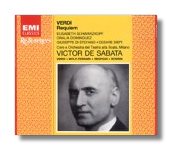
The Internet's Premier Classical Music Source
Related Links
- Verdi Reviews
- Latest Reviews
- More Reviews
-
By Composer
-
Collections
DVD & Blu-ray
Books
Concert Reviews
Articles/Interviews
Software
Audio
Search Amazon
Recommended Links
Site News
 CD Review
CD Review
Giuseppe Verdi

Messa da Requiem
- Messa da Requiem
- La Traviata
- Vespri siciliani (Sicilian Vespers)
- Ermanno Wolf-Ferrari:
- Quattro Rusteghi (The Four Ruffians)
- Segreto di Susanna (Susanna's Secret)
- Ottorino Respighi: Fontane di Roma (Fountains of Rome)
- Gioachino Rossini: Overture "Guillaume Tell"
Elisabeth Schwarzkopf, soprano
Oralia Dominguez, mezzo-soprano
Giuseppe di Stefano, tenor
Cesare Siepi, bass
Orchestra & Chorus of La Scala, Milan/Victor de Sabata (Requiem)
Orchestra Stabile Accademia di Santa Cecilia, Rome/Victor de Sabata (orchestral excerpts)
EMI Références ZDHB 65506 ADD monaural 2CDs: 73:51, 74:32
Maria Callas's first commercial recording of Tosca still is a top pick after more than forty years, thanks in no small part to the penetrating conducting of Victor de Sabata. De Sabata never got the attention that his colleagues Toscanini and Cantelli did, but he was deeply respected by musicians and audiences in the decades before and after World War II. Not comfortable in the recording studios, he nevertheless left several noteworthy recordings behind. This Verdi Requiem, produced by Walter Legge, was taped in 1954, and has been a dark horse favorite ever since. De Sabata leads an uncommonly broad reading - the total timing is 95:05 - that manages to blaze with drama and energy in spite of its slowness. The orchestra and chorus are this recording's glories. Some listeners will come to punches over the soloists, however. Callas allegedly had been considered for this recording, and her contribution probably would have been controversial. Schwarzkopf's is controversial in an entirely different way. If one can get over the fact that her voice is far from Italianate to begin with, then one has to deal with her delivery, which is even more unidiomatic. She is constantly pushing herself forward, like the puppy who is the most eager to be adopted from a litter of four, or like the child star in "Ruthless!" Brilliant and steely in its upper ranges, her voice takes on a vehement, even vindictive quality when it descends lower in the staff. (It's almost as if she's personally offended that God has disturbed her kaffeeklatsch with His noisy Last Judgment.) When this happens, look out for flying aspirates ("fons pieta-ha-ha-ha-ha-tis"). I don't dislike her singing per se, but it's too vinegary for Verdi's Requiem. Di Stefano's voice was at his best in 1954, and no one can accuse him of not understanding Verdian style. He's ardent, but he's a bit of a cry-baby in the "Ingemisco" (but we've all heard worse) and in other places, and he's not subtle - he sings like a healthy race-horse looks. The quartet's finest vocalist is the Mexican mezzo Oralia Dominguez. Her singing is positive yet devout, and her voice has a richness that contrasts well with Schwarzkopf's. As with Cesare Siepi, one could ask for a more darker colored voice in this music, but not for an interpretation that is better integrated with the whole, or more faithful to Verdian ideals. The engineering is about average for that era.
The orchestral excerpts were recorded in 1947 and 1948. De Sabata's interpretations are similar to Toscanini's - if only de Sabata had had the NBC Symphony Orchestra to work with! At times the Academy of Santa Cecilia is comically sloppy (try the William Tell overture), and at other times they pull themselves together to stunning effect. If you like The Fountains of Rome, this is one of its most dramatic recordings. The Préludes from La Traviata and the overture to I Vespri Siciliani are lessons on how opera should be conducted. It's unfortunate that de Sabata recorded so few complete operas; was there anything else besides his EMI Tosca with Callas?
Copyright © 1996, Raymond Tuttle


















